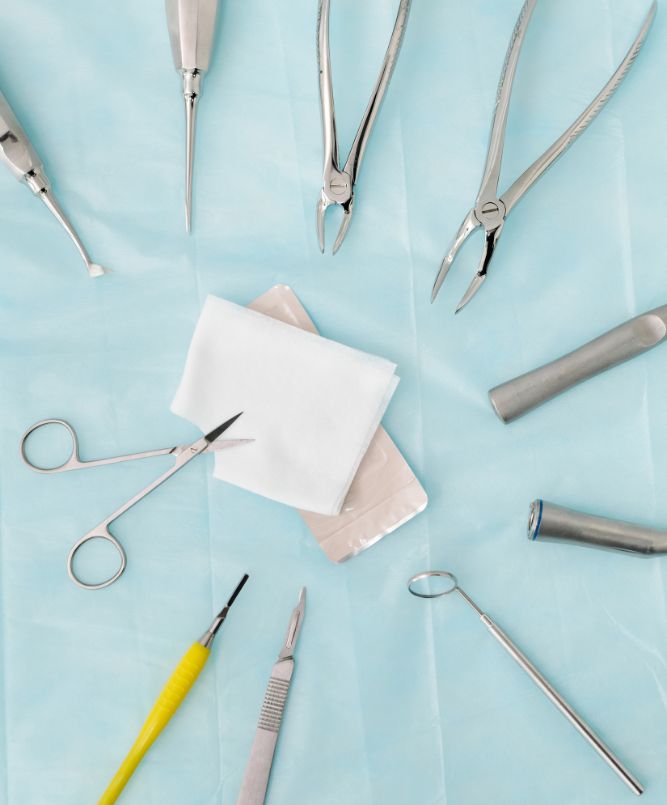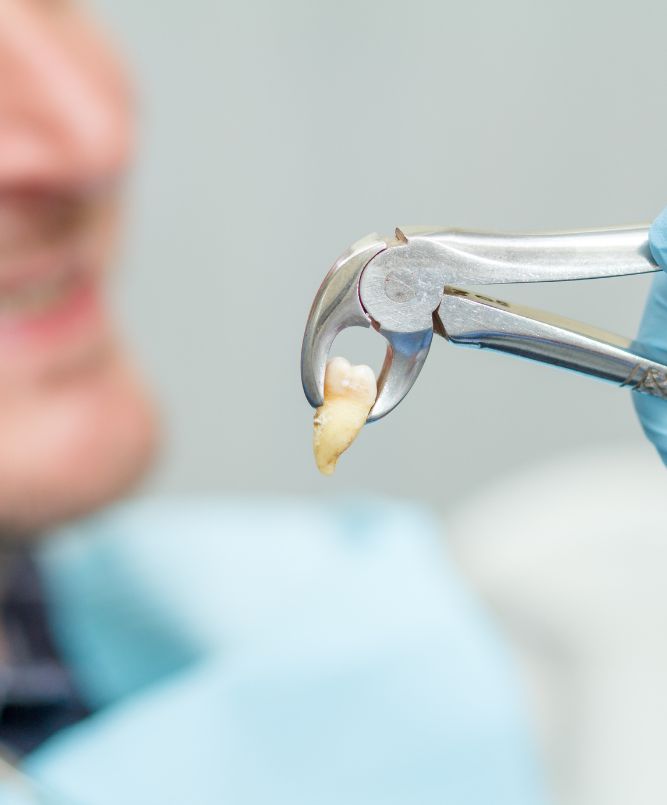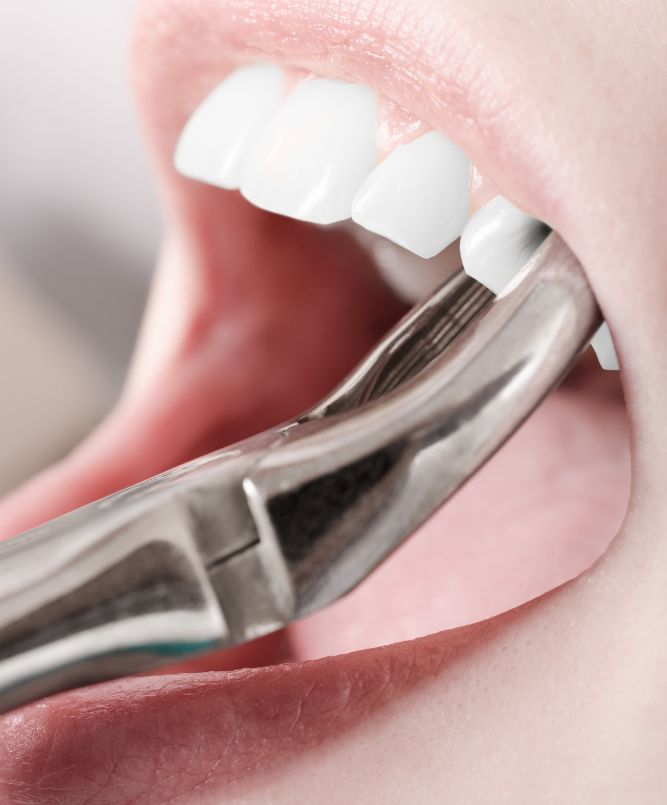Impacted, decayed, or improperly aligned wisdom teeth, also referred to as third molars, are the last set of permanent teeth to emerge in the mouth and often present problems. Frequently, these teeth struggle with inadequate space for eruption, improper
The extractions are done in dental offices, by the dentist or dental surgeon (a dentist with surgery specialization), under local or general anesthesia. Professional extraction is recommended when tooth decay is severe, and nothing can be done to save the tooth, when the tooth is affected by infection or is vulnerable to infection, because of a gum disease or a health condition.
Type of extractions
There are two main types of extraction, influenced by the complexity of the procedure:
Simple extractions: The dentist uses the elevator to loosen up the tooth, followed by forceps to remove it completely. In more complicated cases, the tooth may be removed in pieces for the patient’s comfort. The simple extraction is performed exclusively under local anesthesia.
Surgical extractions: It is performed by the dental surgeon and it is used only in cases where simple extraction is not possible. When only one tooth must be removed through this procedure, the local anesthetic is used. When two or more teeth need to be extracted, the extraction procedure is done under general anesthesia for the patient’s comfort, as well as to ease things up for the dentist.


Preparation for dental extraction
A full report on the patient’s health condition and an X-ray of the targeted tooth are necessary for any safe tooth extraction. The extraction of wisdom teeth may require a full mouth X-ray to see the exact position of the tooth and its connection with the neighboring tooth. When the patient is cold and has symptoms such as nausea and vomiting, such a procedure is not recommended. Also, antibiotics may be prescribed before the procedure to avoid infection during the intervention.
The patient is recommended not to smoke on the day of the extraction to avoid complications.
The Procedure
Regardless of the type of extraction performed, the main steps are the same: anesthetic to numb the area, tooth loosening, and tooth removal. A blood clot forms in the remaining socket. To stop the bleeding, the dentist asks the patient to bite down on a gauze pad. A few resorbing stitches close the socket and end the procedure.
Post-procedure extraction care
After the extraction, it is necessary to follow the dentist’s advice. There are a few rules that each patient must apply after such a procedure:
✓ Take painkillers and antibiotics as prescribed;
✓ Do not smoke or reduce the number of cigarettes as possible as it may inhibit healing;
✓ Refrain from spitting, rinse forcefully, or drink with a straw in the first 24 hours to avoid dislocating the blood clot formed in the socket.
✓ Adapt the menu to the condition and eat mainly soft food after the procedure. Introduce solid food gradually and avoid biting and chewing on the affected side to prevent high pressure on the exposed gum;
✓ Follow carefully the dental hygiene to prevent infection. Avoid the extraction area to avoid irritation.
✓ Rest for the day or until the anesthetic fades off.


Reasons for Urgent Tooth Removal:
✓ Advanced Tooth Decay: When decay progresses to severe cavities or abscesses, extraction may be the only option if repair is not viable.
✓ Gum Disease: In severe cases like periodontitis, tooth extraction might be necessary as other treatments are ineffective.
✓ Tooth Fracture Below Gums: Forces from chewing can fracture lower molars, making immediate removal essential.
✓ Dental Crowding: When there’s not enough room for teeth to properly align, extraction may be required to facilitate orthodontic alignment.
Impacted Wisdom Teeth: These back molars frequently encounter a lack of space, becoming trapped under the gum line and necessitating removal to avoid further issues.
Our Google Reviews
Wisdom Tooth Extractions in Jersey City
The extraction is done in dental offices, by the dentist or dental surgeon (a dentist with surgery specialization), under local or general anesthesia. Professional extraction is recommended when tooth decay is severe, and nothing can be done to save the tooth, when the tooth is affected by infection or is vulnerable to infection, because of a gum disease or a health condition.
Type of extraction
There are two main types of extraction, influenced by the complexity of the procedure:
Simple extraction: The dentist uses the elevator to loosen up the tooth, followed by forceps to remove it completely. In more complicated cases, the tooth may be removed in pieces for the patient’s comfort. The simple extraction is performed exclusively under local anesthesia.
Surgical extraction: It is performed by the dental surgeon and it is used only in cases where simple extraction is not possible. When only one tooth must be removed through this procedure, the local anesthetic is used. When two or more teeth need to be extracted, the extraction procedure is done under general anesthesia for the patient’s comfort, as well as to ease things up for the dentist.
Dental Impactions
Preparation for dental extraction
A full report on the patient’s health condition and an X-ray of the targeted tooth are necessary for any safe tooth extraction. The extraction of wisdom teeth may require a full mouth X-ray to see the exact position of the tooth and its connection with the neighboring tooth. When the patient is cold and has symptoms such as nausea and vomiting, such a procedure is not recommended. Also, antibiotics may be prescribed before the procedure to avoid infection during the intervention.
The patient is recommended not to smoke on the day of the extraction to avoid complications.
The Procedure
Regardless of the type of extraction performed, the main steps are the same: anesthetic to numb the area, tooth loosening, and tooth removal. A blood clot forms in the remaining socket. To stop the bleeding, the dentist asks the patient to bite down on a gauze pad. A few resorbing stitches close the socket and end the procedure.
Post-procedure extraction care
After the extraction, it is necessary to follow the dentist’s advice. There are a few rules that each patient must apply after such a procedure:
- Take painkillers and antibiotics as prescribed;
- Do not smoke or reduce the number of cigarettes as possible as it may inhibit healing;
- Refrain from spitting, rinse forcefully, or drink with a straw in the first 24 hours to avoid dislocating the blood clot formed in the socket.
- Adapt the menu to the condition and eat mainly soft food after the procedure. Introduce solid food gradually and avoid biting and chewing on the affected side to prevent high pressure on the exposed gum;
- Follow carefully the dental hygiene to prevent infection. Avoid the extraction area to avoid irritation.
- Rest for the day or until the anesthetic fades off.
Extraction should not be painful, and if the patient experiences pain during the procedure, the patient should let the dentist know to adjust the procedure. If the patient experiences severe pain and bleeding that does not stop after the first 24 hours of the procedure, it is necessary to contact the dentist for further instructions.

